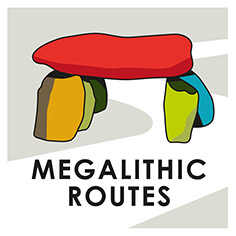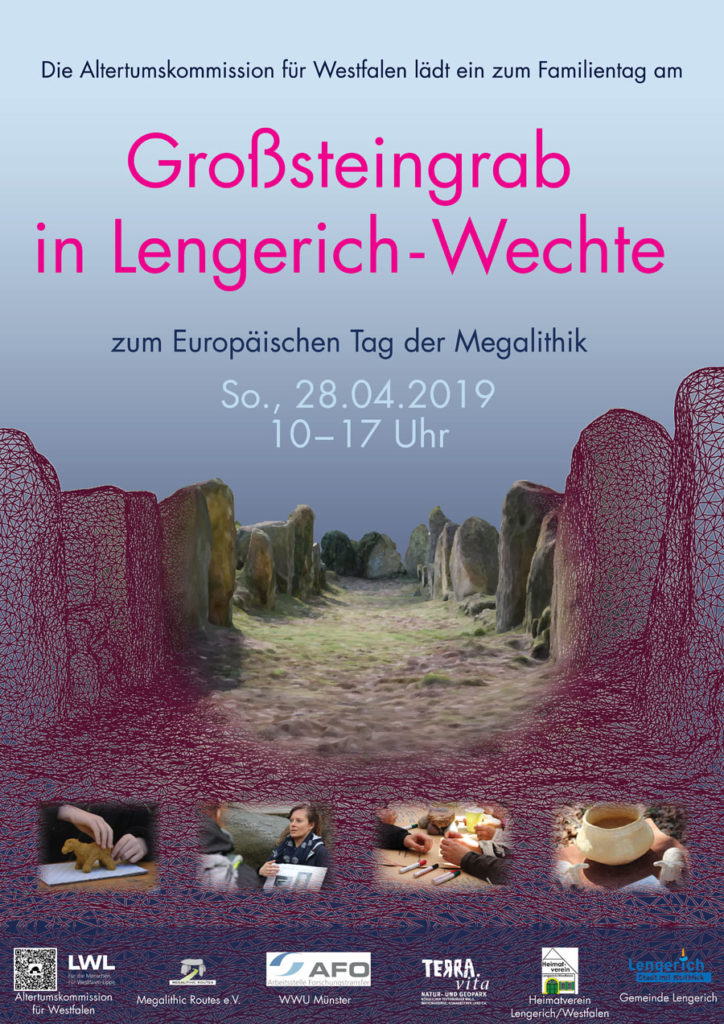European Day of Megalithic Culture 2019
European Day of Megalithic Culture in Lengerich-Wechte
The Commission for Westphalian Antiquities invites to the 5th Day of Megalithic Culture in Westphalia.
This year’s focus is on the passage grave in Lengerich-Wechte (An der Papiermühle 12). A reconstructed megalithic tomb from Late-Neolithic times in Westphalia. The monument is a good example for today’s reception of the more than 5.000 years old history in modern cultural memory and is therefore the best place to host the fifth Day of Megalithic Culture in Westphalia.
From 10:00 to 17:00 the Commission for Westphalian Antiquities and its partners will welcome all visitors with a varied program. Visitors not only hear new and interesting facts about the grave but also can be productive by themselves. With archaeologist Dr. Claudia Siemann the visitors can make neolithic pottery like it was found in the grave, while the Commission for Westphalian Antiquities offers the chance to produce own Stone Age jewelry, also found in the grave in Lengerich-Wechte. At 14:00 the World Café of the University of Münster opens. Dr. Wilhelm Bauhus and his team invite all visitors to be part in a relaxed round with discussions, coffee and cake.
In addition to these activities, the archaeologists of the Commission of Westphalian Antiquities will answer questions about the megalithic past and how it is possible to know that much about those long gone times. Dr. Kerstin Schierhold and Dr. Bernhard Stapel compiled several news about the grave and will provide detailed information in guided tours at 10.30, 13:30 and 16:00. The archaeologists will be supported by Dr. Tobias Fischer, geologist of the TERRA.vita Nature Park, who can refer to the geological origin of the big stones. For the first time there will be guided tours also for children. Archaeologist Catrin Becker and the kids will explore the grave at 11.00 and 14:00 and will find out how the people who are buried in this place lived 5.000 years ago.
At their info stall the Commission for Westphalian Antiquities presents a movie with a 3D-view of the passage grave on which expert Leo Klinke can show how modern technologies are used in archaeology and be a base for future researches.
The entrance is free!
International Day of Megalithic Culture: Megaliths in Schleswig-Holstein
On April 28, 2019, ‘The European Day of Megalithic Culture’ will take place for the seventh time.
What are megaliths?
Already the term “megalith” has a mystic allure. It is derived from the Greek terms μέγας or mégas (Engl. “large”) and λίθος or líthos (Engl. “stone”), and is used for a variety of Neolithic cultic and sepulchral monuments. It is a global phenomenon. Such monuments appear archaic in the modern landscape and have been part of past and contemporary commemorative culture.
Around 5000 BC impressive megaliths appear as a pan-European tradition, with the first monuments in Brittany and the Iberian Peninsula. The megaliths in the northern part of Central Europe date into the Neolithic between 4800 and 2500 BC. This makes them the oldest built remains in Central Europe. In Schleswig-Holstein the megalithic tomb is the most common monument, which is distinguished into different types based on their construction. The oldest type seems to be the so-called dolmen, a younger type the passage tomb. These are tombs, in which the passage is connected transversely or diagonally to the burial chamber. Dolmen or passage tombs can either be covered by oblong or circular mounds, which base is comprised by stones. These are part of the so-called Funnel Beaker Culture, which is regarded as the first peasant society in northern Europe and erected its megaliths mainly in the period between 3650 and 3100 BC, thus before the first pyramids were built in Egypt.
The Project
In 2013, the “European Route of Megalithic Culture” was recognised as Cultural Route by the Council of Europe and since then the members of Megalithic Routes have been holding this international day of Megalithic Culture. In Schleswig-Holstein so far only the “Steinzeitpark Dithmarschen” (Stone Age Park Dithmarschen) is member of the international association “Megalithic Routes e. V.”, which advocates the preservation, care and presentation of megaliths throughout Europe. Against this background and the European Cultural Heritage Year 2018 +1 under the context “Sharing Heritage”, the State Archaeology Department of Schleswig-Holstein (ALSH) and the Stone Age Park Dithmarschen used the chance to jointly initiate a project in September last year for the valorisation of European routes of the megalithic culture and its archaeological legacy in Schleswig-Holstein.Thus, in 2019, the European Day of Megalithic Culture in Schleswig-Holstein will be duly celebrated. Further information are available on: https://www.schleswig-holstein.de/DE/Landesregierung/ALSH/Projekte/MegalithicRoutes/megalithicRoutes.html
The European Day of Megalithic Culture
This year’s motto of this day of action is “Voluntary Working Groups”. On this day, various non-profit groups, organizations and associations offer events and activities at various megalithic sites in Schleswig-Holstein, which are accessible to visitors and tourists. The aim is the promotion of megalithic monuments as significant and visible testimonies in stone of thousands of years of history.
The European Day of Megalithic Culture in Schleswig-Holstein is funded by the Federal Commissioner for Culture and the media (BKM) in the context of the European Heritage Year 2018 + 1 under the motto “Sharing Heritage”.
Today, all known and unknown megaliths are protected against destruction by the Monument Protection Law. However, to preserve the archaeological heritage in the long term, it always needs the support of the people. Large stone tombs such as the Denghoog on Sylt, the Brutkamp in Dithmarschen, the reconstructed megalithic tomb of Karlsminde or the Arnkiel-Park of Munkwolstrup are supported by volunteer commitment, and thus also preserved. Visit the nearest megalithic site in your area!



